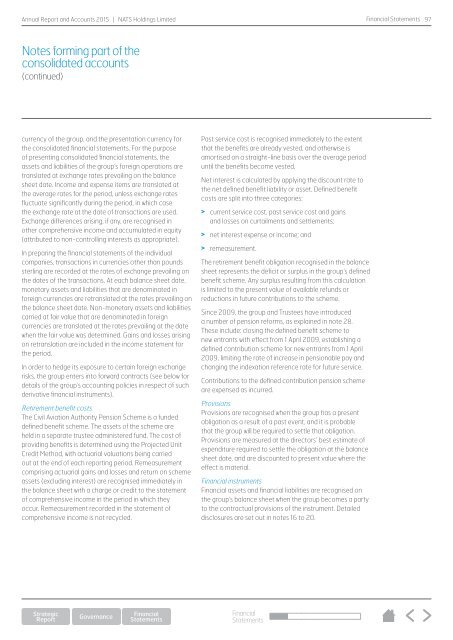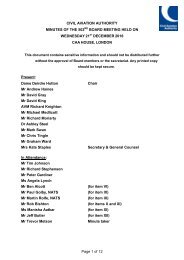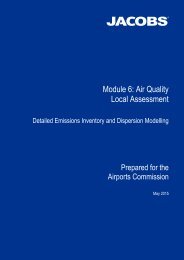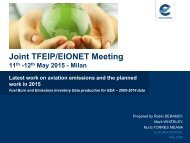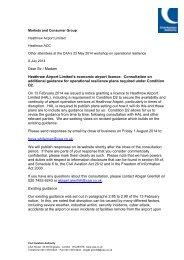NATS-Annual-Report-2015
NATS-Annual-Report-2015
NATS-Annual-Report-2015
You also want an ePaper? Increase the reach of your titles
YUMPU automatically turns print PDFs into web optimized ePapers that Google loves.
<strong>Annual</strong> <strong>Report</strong> and Accounts <strong>2015</strong> | <strong>NATS</strong> Holdings Limited<br />
Financial Statements 97<br />
Notes forming part of the<br />
consolidated accounts<br />
(continued)<br />
currency of the group, and the presentation currency for<br />
the consolidated financial statements. For the purpose<br />
of presenting consolidated financial statements, the<br />
assets and liabilities of the group’s foreign operations are<br />
translated at exchange rates prevailing on the balance<br />
sheet date. Income and expense items are translated at<br />
the average rates for the period, unless exchange rates<br />
fluctuate significantly during the period, in which case<br />
the exchange rate at the date of transactions are used.<br />
Exchange differences arising, if any, are recognised in<br />
other comprehensive income and accumulated in equity<br />
(attributed to non-controlling interests as appropriate).<br />
In preparing the financial statements of the individual<br />
companies, transactions in currencies other than pounds<br />
sterling are recorded at the rates of exchange prevailing on<br />
the dates of the transactions. At each balance sheet date,<br />
monetary assets and liabilities that are denominated in<br />
foreign currencies are retranslated at the rates prevailing on<br />
the balance sheet date. Non-monetary assets and liabilities<br />
carried at fair value that are denominated in foreign<br />
currencies are translated at the rates prevailing at the date<br />
when the fair value was determined. Gains and losses arising<br />
on retranslation are included in the income statement for<br />
the period.<br />
In order to hedge its exposure to certain foreign exchange<br />
risks, the group enters into forward contracts (see below for<br />
details of the group’s accounting policies in respect of such<br />
derivative financial instruments).<br />
Retirement benefit costs<br />
The Civil Aviation Authority Pension Scheme is a funded<br />
defined benefit scheme. The assets of the scheme are<br />
held in a separate trustee administered fund. The cost of<br />
providing benefits is determined using the Projected Unit<br />
Credit Method, with actuarial valuations being carried<br />
out at the end of each reporting period. Remeasurement<br />
comprising actuarial gains and losses and return on scheme<br />
assets (excluding interest) are recognised immediately in<br />
the balance sheet with a charge or credit to the statement<br />
of comprehensive income in the period in which they<br />
occur. Remeasurement recorded in the statement of<br />
comprehensive income is not recycled.<br />
Past service cost is recognised immediately to the extent<br />
that the benefits are already vested, and otherwise is<br />
amortised on a straight-line basis over the average period<br />
until the benefits become vested.<br />
Net interest is calculated by applying the discount rate to<br />
the net defined benefit liability or asset. Defined benefit<br />
costs are split into three categories:<br />
> current service cost, past service cost and gains<br />
and losses on curtailments and settlements;<br />
> net interest expense or income; and<br />
> remeasurement.<br />
The retirement benefit obligation recognised in the balance<br />
sheet represents the deficit or surplus in the group’s defined<br />
benefit scheme. Any surplus resulting from this calculation<br />
is limited to the present value of available refunds or<br />
reductions in future contributions to the scheme.<br />
Since 2009, the group and Trustees have introduced<br />
a number of pension reforms, as explained in note 28.<br />
These include: closing the defined benefit scheme to<br />
new entrants with effect from 1 April 2009, establishing a<br />
defined contribution scheme for new entrants from 1 April<br />
2009, limiting the rate of increase in pensionable pay and<br />
changing the indexation reference rate for future service.<br />
Contributions to the defined contribution pension scheme<br />
are expensed as incurred.<br />
Provisions<br />
Provisions are recognised when the group has a present<br />
obligation as a result of a past event, and it is probable<br />
that the group will be required to settle that obligation.<br />
Provisions are measured at the directors’ best estimate of<br />
expenditure required to settle the obligation at the balance<br />
sheet date, and are discounted to present value where the<br />
effect is material.<br />
Financial instruments<br />
Financial assets and financial liabilities are recognised on<br />
the group’s balance sheet when the group becomes a party<br />
to the contractual provisions of the instrument. Detailed<br />
disclosures are set out in notes 16 to 20.<br />
Financial<br />
Statements


